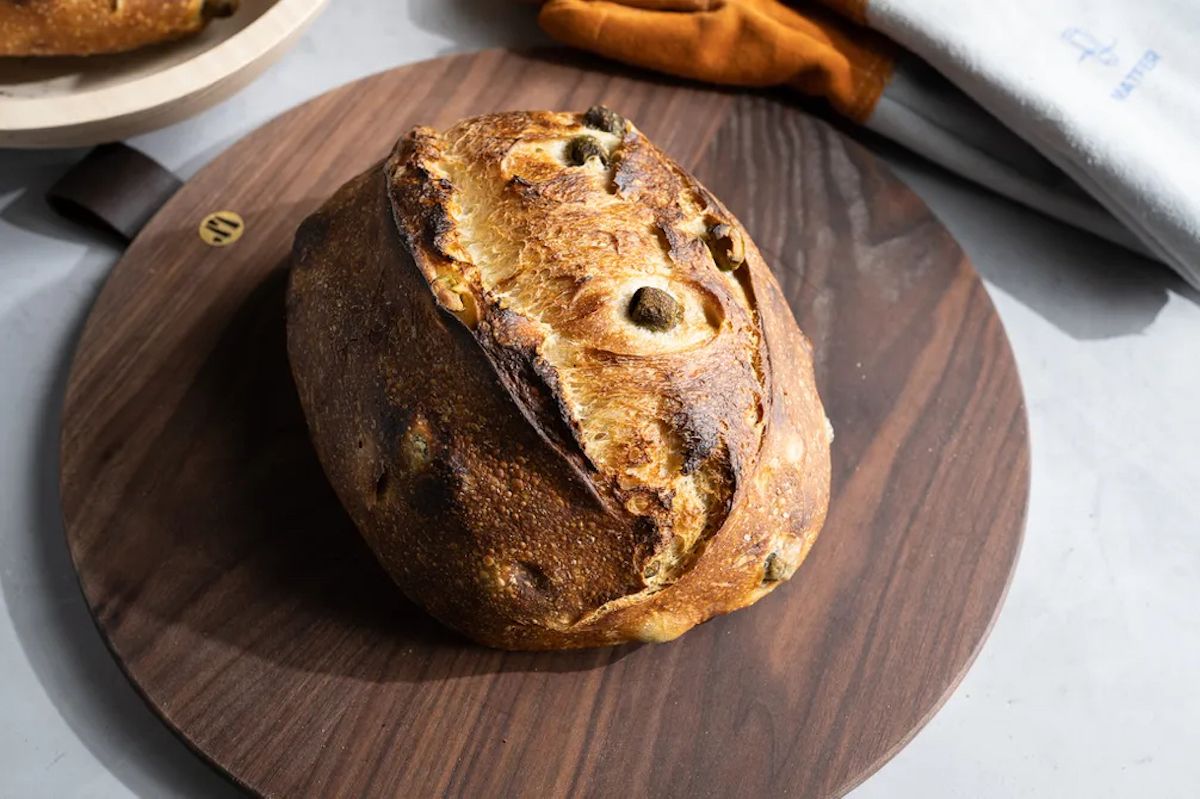Castelvetrano olives are named after an eponymous town in Sicily, where they're grown both for pressing into olive oil and simply for snacking (you might find one in your next martini, too!). Unlike the typical green olive you'd find in a salad or entrée, Castelvetranos' mild flavor comes from being harvested at a younger stage, and because they're typically packed in a brine that has less salt than other jarred olives. The flavor of these bright green gems leans subtly sweet and buttery, with a mellow tang. When compared to the ubiquitous little green olive in a can, the Castelvetrano is larger and substantially meatier, meaning it truly is an olive you can sink your teeth into.
All of these attributes make for an olive that is simply perfect for baking bread. The reduced salt content means less interference with your intended flavor profile (much like a baker who prefers to use unsalted butter so the salt content is completely under their control) and the thick, meaty olive flesh makes for a dramatic presentation in the loaf's cross-sections — and a substantial bite with every slice of bread.
How many olives should I add to the dough?
I find adding a proportion of olives somewhere between 20 and 30% of the total flour to be a good starting point: Any lower and you end up with a loaf that lacks enough olive punch — a bread with olives as opposed to an olive bread. If you go the other direction, a higher than 30% olive-to-flour ratio starts to impact the dough's structure and eating experience, resulting in a loaf that has less height and an overpoweringly olivey flavor.
Through several rounds of test-baking, I found 24% Castelvetranos to total flour weight to be just right. The flavor of the olives permeates the entire loaf even if you don't catch a bite of the fruit. But when you do snag a piece of olive, and this happens often, the flavor is exuberant and rich, lighting up your palate.
If you can't find Castelvetrano olives, swap them out for any pitted green olive you enjoy eating all on their own. Chances are, if you like them as a snacking olive, they'll also be wonderful in a loaf of sourdough bread.
How do I prepare olives for baking?
Olives are typically jarred or canned in a brine, which tends to be rather salty (great for a snack plate and martinis, not so great for bread), so it's best to thoroughly rinse the olives a few hours before you want to add them to your dough to remove the brine and excessive salt, then leave them out to dry on a layer or two of paper or kitchen towels to help wick away even more moisture.
After the olives are rinsed and totally dry, if they still contain their pits, it's necessary to remove them. I find it's easiest to use the side of a wide-bladed knife to smash the olive on a cutting board. Smashing splits the fruit open and exposes the pit, which can then easily be removed and discarded. While pitting olives is a bit of work, I actually prefer starting with olives that still have their pits, as I find the flavor is more intense than their pitted brethren. Additionally, smashing them leaves the fruit into convenient pieces which disperse easier throughout the dough during bulk fermentation.
You can choose to chop the pitted olives further if you'd like them to disperse more thoroughly through each loaf, leave them whole for a more striking presentation, or do a mixture of both.
Why is the salt percentage in the dough slightly lower?
For the vast majority of my lean sourdough bread baking ("lean" meaning doughs that don't include enrichments like dairy, sugar, or eggs), I tend to peg salt to 1.8% of the total flour in a recipe. This is mostly a personal preference, as I find that amount of salt plenty for a tasty loaf of bread, but salt that's anywhere in the range of 1.8 to 2.3% is common for a lean dough. But when adding in olives, which are already salty, it's helpful to reduce the salt percentage slightly to offset the fruit.
For my latest sourdough bread recipe with Castelvetrano olives, I reduced the salt to 1.7% to ensure the final loaf isn't excessively salty. On the surface, 0.1% (meaning only a gram or two less salt) might not seem like a drastic reduction, but I can assure you, the difference is profound.
Why add olive oil to the dough?
In my Olive Oil Sourdough With Castelvetranos, I added a bit of extra-virgin olive oil to the dough for both flavor and texture. Olive oil brings an undeniable fruitiness (which can be more or less pronounced depending on the variety), which certainly complements the olives in this dough, but it also affects the loaf's overall texture. Olive oil, like any fat, inhibits gluten formation, resulting in a loaf that's softer and more tender overall. The added flavor and modified texture make for bread that's texturally a bit different from the classic sourdough boule you'd pick up at a bakery, and if I may say so, a quite deliciously different loaf.




Shares